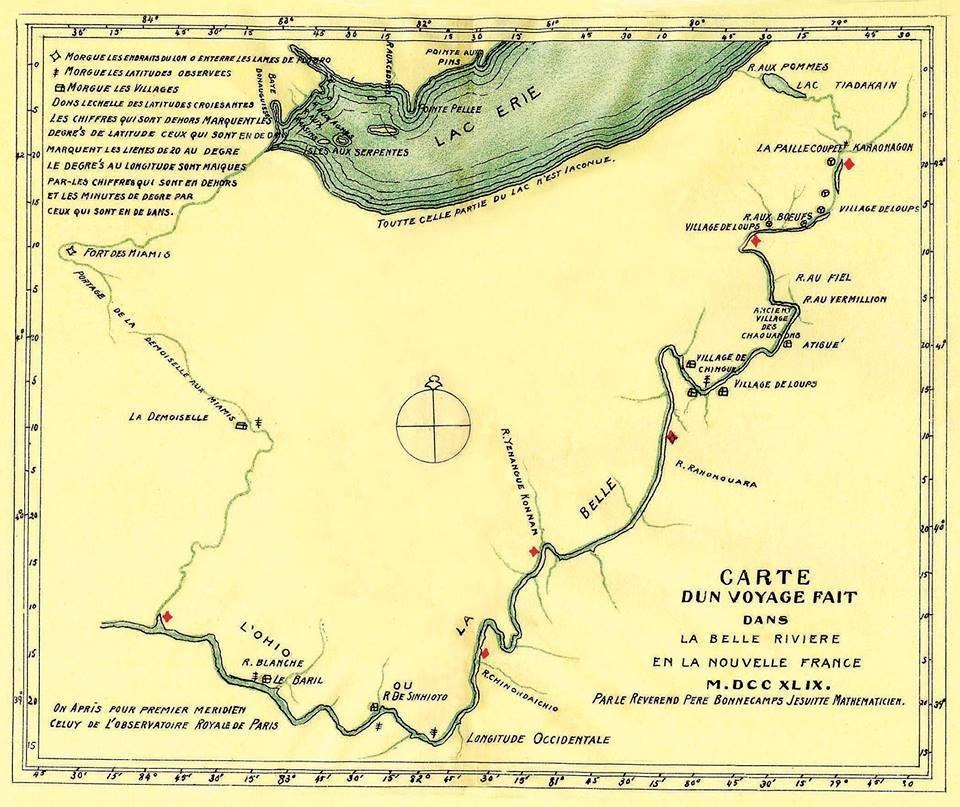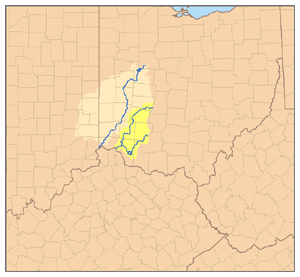|
Piqua, Ohio
Piqua ( ) is a city in Miami County, southwest Ohio, United States, 27 miles north of Dayton. The population was 20,522 at the 2010 census. It is part of the Dayton Metropolitan Statistical Area. It was founded as the village of Washington in 1807 by a soldier under Gen. Anthony Wayne. History Etymology The word 'Piqua' is believed to be derived from a Shawnee language phrase: ''Othath-He-Waugh-Pe-Qua,'' translated as "He has risen from the ashes," related to a legend of the people. It became associated with the ''Pekowi'', one of the five divisions of the Shawnee people, who were eventually known as the Piqua. Fort and trading post In 1749, Fort Pickawillany was constructed by the British to protect their trading post at a Miami village of the same name. It was located at the confluence of Loramie Creek and the Great Miami River. (The present city of Piqua developed about a mile to the southwest). In 1752 Charles de Langlade, an Odawa war chief of partial French Canadia ... [...More Info...] [...Related Items...] OR: [Wikipedia] [Google] [Baidu] |
2010 United States Census
The United States census of 2010 was the twenty-third United States national census. National Census Day, the reference day used for the census, was April 1, 2010. The census was taken via mail-in citizen self-reporting, with enumerators serving to spot-check randomly selected neighborhoods and communities. As part of a drive to increase the count's accuracy, 635,000 temporary enumerators were hired. The population of the United States was counted as 308,745,538, a 9.7% increase from the 2000 census. This was the first census in which all states recorded a population of over half a million people as well as the first in which all 100 largest cities recorded populations of over 200,000. Introduction As required by the United States Constitution, the U.S. census has been conducted every 10 years since 1790. The 2000 U.S. census was the previous census completed. Participation in the U.S. census is required by law of persons living in the United States in Title 13 of the United ... [...More Info...] [...Related Items...] OR: [Wikipedia] [Google] [Baidu] |
Raid On Pickawillany
"ash people" , settlement_type = Historic Native American village , image_skyline = , imagesize = , image_alt = , image_map1 = OHMap-doton-Piqua.png , mapsize1 = 220px , map_caption1 = Location of Pickawillany Village , image_caption = , nickname = , coordinates = , established_title = Founded , established_date = 1747 , established_title2 = Demolished , established_date2 = 21 June, 1752 , established_title3 = , established_date3 = , population_total = , population_est = 400 families (1200–1600 people) , pop_est_as_of = 1750 , subdivision_type = State , subdivision_name = Ohio , subdivision_type1 = Present-day community , subdivision_name1 = Piqua, Ohio , subdivision_type2 = County , subdivision_name2 = Miami , image_map = Ohio in ... [...More Info...] [...Related Items...] OR: [Wikipedia] [Google] [Baidu] |
Ojibwe
The Ojibwe, Ojibwa, Chippewa, or Saulteaux are an Anishinaabe people in what is currently southern Canada, the northern Midwestern United States, and Northern Plains. According to the U.S. census, in the United States Ojibwe people are one of the largest tribal populations among Native American peoples. In Canada, they are the second-largest First Nations population, surpassed only by the Cree. They are one of the most numerous Indigenous Peoples north of the Rio Grande. The Ojibwe population is approximately 320,000 people, with 170,742 living in the United States , and approximately 160,000 living in Canada. In the United States, there are 77,940 mainline Ojibwe; 76,760 Saulteaux; and 8,770 Mississauga, organized in 125 bands. In Canada, they live from western Quebec to eastern British Columbia. The Ojibwe language is Anishinaabemowin, a branch of the Algonquian language family. They are part of the Council of Three Fires (which also include the Odawa and Potawatomi) and ... [...More Info...] [...Related Items...] OR: [Wikipedia] [Google] [Baidu] |
Odawa
The Odawa (also Ottawa or Odaawaa ), said to mean "traders", are an Indigenous American ethnic group who primarily inhabit land in the Eastern Woodlands region, commonly known as the northeastern United States and southeastern Canada. They have long had territory that crosses the current border between the two countries, and they are federally recognized as Native American tribes in the United States and have numerous recognized First Nations bands in Canada. They are one of the Anishinaabeg, related to but distinct from the Ojibwe and Potawatomi peoples. After migrating from the East Coast in ancient times, they settled on Manitoulin Island, near the northern shores of Lake Huron, and the Bruce Peninsula in the present-day province of Ontario, Canada. They considered this their original homeland. After the 17th century, they also settled along the Ottawa River, and in the present-day states of Michigan and Wisconsin, as well as through the Midwest south of the Great Lakes i ... [...More Info...] [...Related Items...] OR: [Wikipedia] [Google] [Baidu] |
Charles Michel De Langlade
Charles Michel Mouet de Langlade (9 May 1729 – after 26 July 1801)''Dictionnaire Généalogique Tanguay'' was a Great Lakes fur trader and war chief who was important in protecting French territory in North America. His mother was Ottawa and his father a French Canadian fur trader. Fluent in Ottawa and French, Langlade later led First Nations forces in warfare in the region. Given the shifting political realities of the time, he and his followers were at various times allied with the French, British and, lastly, Americans. Leading French and Indian forces, in 1752 he destroyed Pickawillany, a Miami village and British trading post in present-day Ohio, where the British and French were competing for control of the lucrative fur trade. During the subsequent Seven Years' War, he helped defend Fort Duquesne (Pittsburgh) against the British. The French appointed Langlade as second in command at Fort Michilimackinac and a captain in the Indian Department of French Canada. After the d ... [...More Info...] [...Related Items...] OR: [Wikipedia] [Google] [Baidu] |
Great Miami River
The Great Miami River (also called the Miami River) (Shawnee: ''Msimiyamithiipi'') is a tributary of the Ohio River, approximately long,U.S. Geological Survey. National Hydrography Dataset high-resolution flowline dataThe National Map , accessed May 19, 2011 in southwestern Ohio and Indiana in the United States. The Great Miami originates at the man-made Indian Lake and flows south through the cities of Sidney, Piqua, Troy, Dayton, Middletown and Hamilton. The river is named for the Miami, an Algonquian-speaking Native American people who lived in the region during the early days of European settlement. They were forced to relocate to the west to escape pressure from European-American settlers. The region surrounding the Great Miami River is known as the Miami Valley. This term is used in the upper portions of the valley as a moniker for the economic-cultural region centered primarily on the Greater Dayton area. As the lower portions of the Miami Valley fall under the inf ... [...More Info...] [...Related Items...] OR: [Wikipedia] [Google] [Baidu] |
Loramie Creek
Loramie Creek is a U.S. Geological Survey. National Hydrography Dataset high-resolution flowline dataThe National Map, accessed May 19, 2011 tributary of the Great Miami River in western Ohio in the United States. Via the Great Miami and Ohio rivers, it is part of the watershed of the Mississippi River, draining an area of . According to the Geographic Names Information System, the stream has also been known historically as "Laramie Creek," "Loramie Ditch," "Loramies Creek," and "Lonamie Creek." It is named after Louis Lorimier, a French-Canadian fur trader who had a trading post in the area in the 18th century. Loramie Creek rises in northern Shelby County and initially flows southwestwardly, passing through a dam which causes the creek to form Lake Loramie, along which a state park is located. Near Fort Loramie the creek turns southeastwardly, flowing through Lockington Dam (a dry dam) and past the community of Lockington. It flows into the Great Miami River in northern ... [...More Info...] [...Related Items...] OR: [Wikipedia] [Google] [Baidu] |
Miami People
The Miami (Miami-Illinois: ''Myaamiaki'') are a Native American nation originally speaking one of the Algonquian languages. Among the peoples known as the Great Lakes tribes, they occupied territory that is now identified as North-central Indiana, southwest Michigan, and western Ohio. The Miami were historically made up of several prominent subgroups, including the Piankeshaw, Wea, Pepikokia, Kilatika, Mengakonkia, and Atchakangouen. In modern times, Miami is used more specifically to refer to the Atchakangouen. By 1846, most of the Miami had been forcefully displaced to Indian Territory (initially to what is now Kansas, and later to what is now part of Oklahoma). The Miami Tribe of Oklahoma are the federally recognized tribe of Miami Indians in the United States. The Miami Nation of Indiana, a nonprofit organization of descendants of Miamis who were exempted from removal, have unsuccessfully sought separate recognition. Name The name Miami derives from ''Myaamia'' (plural ''M ... [...More Info...] [...Related Items...] OR: [Wikipedia] [Google] [Baidu] |
Pickawillany
"ash people" , settlement_type = Historic Native American village , image_skyline = , imagesize = , image_alt = , image_map1 = OHMap-doton-Piqua.png , mapsize1 = 220px , map_caption1 = Location of Pickawillany Village , image_caption = , nickname = , coordinates = , established_title = Founded , established_date = 1747 , established_title2 = Demolished , established_date2 = 21 June, 1752 , established_title3 = , established_date3 = , population_total = , population_est = 400 families (1200–1600 people) , pop_est_as_of = 1750 , subdivision_type = State , subdivision_name = Ohio , subdivision_type1 = Present-day community , subdivision_name1 = Piqua, Ohio , subdivision_type2 = County , subdivision_name2 = Miami , image_map = Ohio in ... [...More Info...] [...Related Items...] OR: [Wikipedia] [Google] [Baidu] |
Shawnee People
The Shawnee are an Algonquian-speaking indigenous people of the Northeastern Woodlands. In the 17th century they lived in Pennsylvania, and in the 18th century they were in Pennsylvania, Ohio, Indiana and Illinois, with some bands in Kentucky and Alabama. By the 19th century, they were forcibly removed to Missouri, Kansas, Texas, and ultimately Indian Territory, which became Oklahoma under the 1830 Indian Removal Act. Today, Shawnee people are enrolled in three federally recognized tribes, all headquartered in Oklahoma: the Absentee-Shawnee Tribe of Indians, Eastern Shawnee Tribe of Oklahoma, and Shawnee Tribe. Etymology Shawnee has also been written as Shaawanwaki, Ša·wano·ki, Shaawanowi lenaweeki, and Shawano. Algonquian languages have words similar to the archaic ''shawano'' (now: ''shaawanwa'') meaning "south". However, the stem ''šawa-'' does not mean "south" in Shawnee, but "moderate, warm (of weather)": See Charles F. Voegelin, "šawa (plus -ni, -te) MODERATE, WARM. ... [...More Info...] [...Related Items...] OR: [Wikipedia] [Google] [Baidu] |
Pekowi
Pekowi was the name of one of the five divisions (or bands) of the Shawnee, a Native American people, during the 18th century. The other four divisions were the Chalahgawtha, Mekoche, Kispoko, and Hathawekela. Together these divisions formed the loose confederacy that was the Shawnee tribe. All five Shawnee division names have been spelled in a great variety of ways. Variations of the name "Pekowi" are reflected in many place names in the United States, including Piqua, Pickawillany, Pickaway, and Pequea. Traditionally, Shawnee ritual leaders came from the Pekowi patrilineal division. From 1737 to about 1750 the Pekowi were led by Peter Chartier (born Pierre Chartier), a fur trader of Pekowi and French colonial parentage. He was recognized as a leader and rose to be chief of the band. Through his mother's line, Chartier was the grandson of chief Straight Tail Meaurroway Opessa. In 1710 he married his cousin, ''Blanceneige-Wapakonee'' Opessa and they had three children: two s ... [...More Info...] [...Related Items...] OR: [Wikipedia] [Google] [Baidu] |



.jpg)


.jpg)

